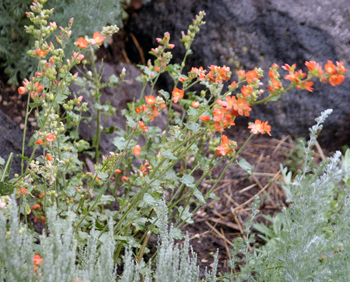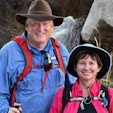 |
| Tiered beds of varied sagebrush and other native plants |
We live on the slope of Boulder Mountain, UT (7,500 ft. elevation). Our house and property are in the pinyon and juniper woodland zone. That means that our surrounding landscape is dominated by pinyon pine (Pinus edulis) and species of juniper (Juniperus osteosperma). We also have a few Ponderosa Pines and Douglas fir. A few miles away, we can visit Bristlecone Pines.
Our average yearly precipitation (rain and snowfall) is 6-7 inches. The arid, high altitude climate is characterized by cold winters (Dec-Jan night time temps can drop into the minus teens, but our usual sunny days see temps raise into the mid-twenties or higher) and a few hot, summer days mid to late July highs rise above ninety degrees combined with cool, comfortable nights). But weather in our Intermountain West region is variable. We sometimes get a 'January thaw' that provides a welcome relief or have a summer season with few hot days. We very seldom need or use air conditioning.
Our average yearly precipitation (rain and snowfall) is 6-7 inches. The arid, high altitude climate is characterized by cold winters (Dec-Jan night time temps can drop into the minus teens, but our usual sunny days see temps raise into the mid-twenties or higher) and a few hot, summer days mid to late July highs rise above ninety degrees combined with cool, comfortable nights). But weather in our Intermountain West region is variable. We sometimes get a 'January thaw' that provides a welcome relief or have a summer season with few hot days. We very seldom need or use air conditioning.
 |
| Young and old Ponderosa pine (Pinus ponderosa). |
Traces of an old wagon road can still be faintly seen winding up the valley wash and ending on the southwest corner of our lot. Locals tell us that Teasdale bench residents once used that route to gather firewood up here. There is also an old stock trail coming down from above; its overturned white rock pathway can be traced to upper grassland areas to intersect with the Coleman Donkey Reservoir road. Seasonal hunters, a few hikers and horsemen, and ranchers were probably infrequent visitors to our location. Today we can also find traces of earlier visitors. In the sandy slope in front of our house, each new rain often brings a few more stone tool flakes to the surface.
 |
| Indian rice grass was already growing here; added the desert holly. |
So at the time we purchased the land, not many other intrusions had recently impacted here. There were only two possible home sites on the near 10 acres; one in the extreme southwestern corner - - a road ending that we call 'the turnaround.' The other on a small knoll overlook that was adjacent to a 50-60 ft. rock and gravel talus slope down to Cottonwood wash. The wash comes near the turnaround and bisects the southeast corner of our lot to head on down the valley to benchland below (Back of the Coombs' pasture). Our ground is rocky and rolling; there are not many level spots. Other than the road cuts and exposed slickrock inclines, it is covered with trees growing in the rock and gravel base. Dig anywhere and you will hit rocks, dig those rocks out and you will find more rocks underneath. Dig a little further and you will hit sandstone. Sometimes you can 'worry' some of that out with a pick or digging bar, but there's not much dirt! And we don't have a use for a lawnmower.
Before we built the house, we had Lavar Wells (Besides drilling water wells, Lavar has other well known skills) and crew drill a water well that can be used sparingly for landscape plants, but we recognize that water is an expensive and limited resource. After building, we turned attention to the landscape surrounding the high desert house and considered the available water. Two terms became prominent in our thinking and plans - - xeriscaping and native plants. Xeriscaping refers to using methods in landscape design to minimize use of water.
Before we built the house, we had Lavar Wells (Besides drilling water wells, Lavar has other well known skills) and crew drill a water well that can be used sparingly for landscape plants, but we recognize that water is an expensive and limited resource. After building, we turned attention to the landscape surrounding the high desert house and considered the available water. Two terms became prominent in our thinking and plans - - xeriscaping and native plants. Xeriscaping refers to using methods in landscape design to minimize use of water.
 |
| Munro's Globe Mallow (Sphaeralcea munroana); some locals call it stinkweed. |
Useful Online Resources:
Anderson, Berniece (Rev. May 1996). Desert Plants of Utah. Utah State University Extension.
Kuhns, Michael (Rev. May 2008). Conifers of Utah. Utah State University Extension.
Plants from Wild Utah
Weeds and Wildflowers (Utah)
Kuhns, Michael (Rev. May 2008). Conifers of Utah. Utah State University Extension.
Plants from Wild Utah
Weeds and Wildflowers (Utah)
 |
| One of ten Blue Spruce (Picea pungens) that we planted as near twigs. |
Favorite Native Plant Sources:
Bob Emrich
Lives in the Grover area; sells nursery plants at the Farmers' Market in Torrey (4 p.m. Saturdays during the summer at the Robber's Roost Bookstore)
Purchased a few trees plus several shrubs and native flowers / plants. Lost one tree over the winter (lack of water), a Bristlecone Pine (I will replace it when Bob has another seedling ready). Also have some pentstemon flowers and few other plants (Winterfat, moss plant, etc.) - all doing fine.
Good prices and Bob is an excellent source of information too.
Fremont River Conservation District
HC 61
Box 30
Fremont, UT 84773
Phone: (435) 681-0303
Before building, we cleared most of the dead limbs and trees off the property. This fuels reduction was done to lessen the threat of a forest fire, and because our lot is adjacent to the National Forest, it was a required process (Assisted by an in-kind federal grant, administrated by Utah Forestry, Fire and State Lands / UT Dept of Natural Resources). Once the dead limbs and trees were removed, we had a large area away from the house with very little cover. Each spring, our local paper (The Insider) has an article about tree stock that can be purchased via the Fremont River Conservation District. Not all are native plants; however we ordered and received 10 Blue Spruce that are native to our area. Very affordable price but the stock arrives as very small plants. With a drip line installed and regular watering through the dry months, all of them have grown well. Watch for the article in the paper; offered once a year.
Great Basin Natives
http://www.greatbasinnatives.com/
Have not visited the nursery or purchased anything from there; have talked with them on phone. Plan to stop by sometime when in the area.
75 West 300 South
Holden, UT 84636
High Country Gardens in Santa Fe, NM
http://www.highcountrygardens.com/
Ordered several orange Globe Mallow wildflowers online; lost some of them over the winter, rest are thriving and spreading.
Rugged Country Plants
Fremont River Conservation District
HC 61
Box 30
Fremont, UT 84773
Phone: (435) 681-0303
Before building, we cleared most of the dead limbs and trees off the property. This fuels reduction was done to lessen the threat of a forest fire, and because our lot is adjacent to the National Forest, it was a required process (Assisted by an in-kind federal grant, administrated by Utah Forestry, Fire and State Lands / UT Dept of Natural Resources). Once the dead limbs and trees were removed, we had a large area away from the house with very little cover. Each spring, our local paper (The Insider) has an article about tree stock that can be purchased via the Fremont River Conservation District. Not all are native plants; however we ordered and received 10 Blue Spruce that are native to our area. Very affordable price but the stock arrives as very small plants. With a drip line installed and regular watering through the dry months, all of them have grown well. Watch for the article in the paper; offered once a year.
Great Basin Natives
http://www.greatbasinnatives.com/
Have not visited the nursery or purchased anything from there; have talked with them on phone. Plan to stop by sometime when in the area.
75 West 300 South
Holden, UT 84636
High Country Gardens in Santa Fe, NM
http://www.highcountrygardens.com/
Ordered several orange Globe Mallow wildflowers online; lost some of them over the winter, rest are thriving and spreading.
Rugged Country Plants
53671 West Crockett Road
Milton-Freewater, OR 97862
Ordered and received several Indian Paintbrush wildflowers (Difficult to grow; it's been a few years and waiting to see results this spring - know that a few made it). Also purchased several sage plants and they are doing fine (Big Sagebrush, Mountain Big Sagebrush, White Sagebrush, Black Sagebrush, Fringed Sagebrush).
Good prices; watch the timing of placing orders; some plants are only available in early spring or in the fall.
Wildland Nursery
Wildland Nursery
370 E 600 North
Joseph, UT 84739
We have purchased 3 ponderosa pines (7-8 ft tall) and a few desert holly plants. All are thriving.
Janet (owner) requests that people call ahead first. Phone: 435-527-1234 She is also an excellent source of information about native plants and landscaping.
Janet (owner) requests that people call ahead first. Phone: 435-527-1234 She is also an excellent source of information about native plants and landscaping.



